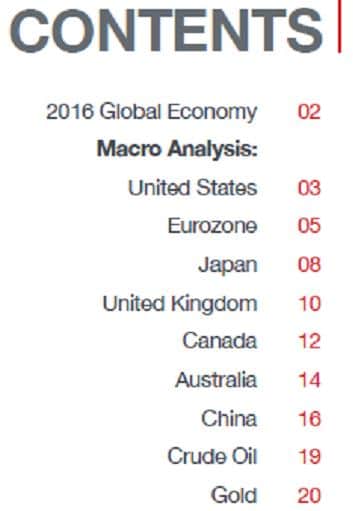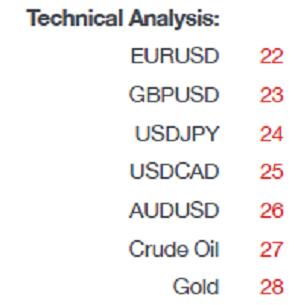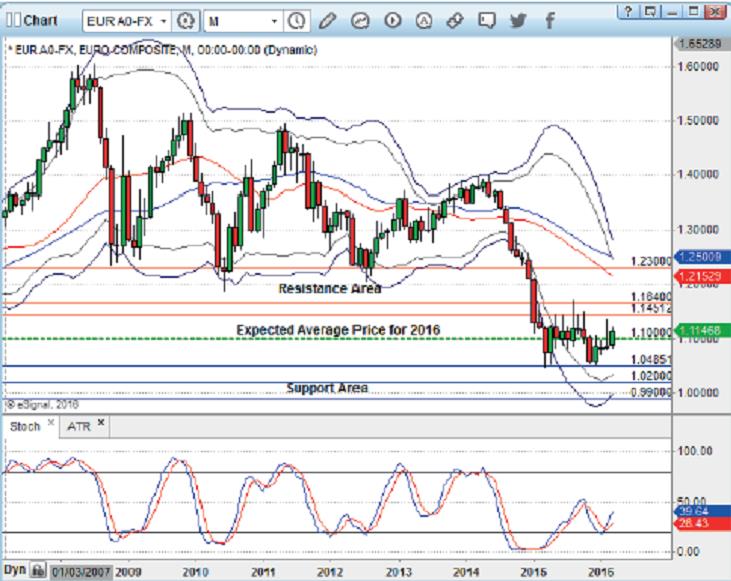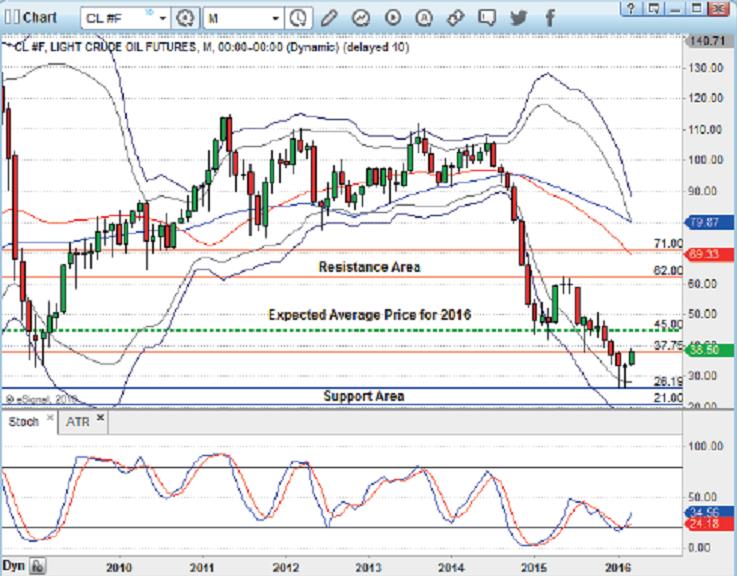First Quarter down; three more to go. Now is a good time to review where you are in your prospective of the market and what you think might be the major drivers for the balance of 2016. Traders in all financial markets, especially in the foreign exchange market, need an understanding of the basic fundamental factors that may distinguish the outlook for one economy over another or relative to the outlook for the global economy.
Yes, there is a subset of the trading community that professes to putting all news feeds on “ignore”, but the vast majority of us accept that forecasting is based on two, not one type of analysis – both fundamental and technical. One complements the other, so to speak. This approach is even more important in forex, since we are dealing with unique currency pairs, where market prices fluctuate, based on the relative strengths and weaknesses of two different and separate economic models.
Where does one go to get an update on industry trends and what might shape the remainder of the year’s market action? Over time, everyone develops their own sources, whether from bank forex departments, a favorite website, or from an analyst that has gained the respect of his colleagues in a world where past results really do matter. I have typically relied on the first two sources, but, occasionally, I will come across the work product of someone that appears to be spot on in his analysis of market conditions and how they might play out over the near term. You might have to search a little deeper for these, but Janne Muta, an analyst for HotForex.com, is just such an individual.
Who is Janne Mata and what is he known for?

Janne Mata is the Chief Market Analyst at HotForex, and per his published bio, “Janne Muta is a seasoned industry professional with over 17 years experience in the global markets. Originally from Finland, Janne has worked for institutions in both Helsinki and London as an institutional fund manager, global market analyst and FX educator. Traders and fund managers from around the world have benefited greatly from Janne’s technical analysis methods. The indicators and price action based trading models he has developed, have, after rigorous testing, proven to be invaluable in identifying high probability trades.”
Mr. Mata’s recent analysis on global trends was released on March 11 and follows the typical framework of most bank forex department outlooks. He begins with a basic overview of the global economy and then delves into a macro fundamental analysis for each of the major countries that are significant in the retail forex trading world, including pieces on the markets for crude oil and gold.
Where Janne differs is that he then follows this discussion with his own individualized technical analysis for key currency pairs, along with sections for oil and gold, as well. Instead of adding a few tables of endless values, as banks are prone to do, Janne includes a chart that supports each of his findings and probable forecasts. It is extremely helpful, at least for me, to get into the analyst’s head to see how he thinks and arrives at positions. Tables are nice, too, but, without a context for the table values, one can easily jump to the wrong conclusions or misinterpret the actual messages presented.
What are the specifics on topics covered in the report?
Here is a reprint of the Table of Contents:


There are 27 pages of “meat” in this report, including fundamental narratives, diagrams focusing on important economic trends, and then fully annotated technical charts that provide evidence for the forecasts put forth. From a technical perspective, he includes Bollinger Bands, moving averages, and other indicators of choice, while pointing out levels of support and resistance, along with the expected average price for the 2016 calendar year. The candlesticks depicted are monthly, in order to reflect longer-term trends, and the pricing data is an aggregate composite, meaning that he has gathered market data from more than one source, a good thing when developing a broader view.
What are Janne Mata’s views on the state of the market and future price action?
Mr. Mata’s perspectives on the macro market moving forces for 2016 are in agreement with the currently prevailing view: The Fed’s interest rate normalization initiative, the deflationary forces driven by falling commodity prices, and China, the big question mark on everyone’s radar screen. The situation in Europe is also omnipresent, but it is seen as improving, if only slightly. Within this context, his defining difference is how he puts his unique spin on the timing of events. Timing is everything in a twelve-month forecast, if you are to correctly posit the trends in prices and their averages over a period of time.
Here are just a few of his views on a selection of countries covered in his report:
United States: The U.S. economy has been leading the developed world out of its long slumber since the Great Recession took hold, but the GDP growth pace of 2.4% in 2015 is predicted to decline somewhat to 2.1%. Retail spending and consumer confidence are also gradually declining. No new news here, but the impact of these trends will, according to Janne, cause the Fed to back off its previous commitment of four rate changes in this year. Problems in China may have already suspended the anticipated March rate hike. Janne is now forecasting that we may only have two adjustments – one in late June or July and one more in December. Overall, however, the long-term trends are seen as positive, despite the headwinds suggesting otherwise in the financial press.
The Eurozone: Europe continues to be crisis driven. The ECB’s version of quantitative easing and Negative Interest Rate Policy (NIRF) have had both positive and negative results. Banks are finally making loans in the small to medium-sized enterprise market, but banks are also seeing their profit margins squeezed by NIRF. Passing along negative interest returns to consumer accounts is viewed as worse than the plague. As a result, bank stocks have been pounded and may take some time to improve. Unemployment may be down to 10%, but it remains high in markets like Spain and in the youth market, which still rests at 22%. Retail spending has improved, but business confidence is waning due to so much of the regional economy, some 45%, depending on the export trade. China plays a major role in this statistic. ECB President, Mario Draghi, has recently stepped in with more stimulus measures, but he also claims that there will be no more. Even with the risks at hand and Arab refuges flooding the region, Janne is inclined to go with consensus growth estimates of 1.6% for GDP growth.
China: The Chinese Experiment continues, but its consequences could severely impact the rest of the global market, since it now is so entwined with every other market across the globe. Large double-digit growth rates will be a thing of the past, since Chinese officials are presently trying to transition the economy along the lines of more developed economies, i.e., being more consumer driven than export drive. During 2015, the retail sector did command a majority of the economy for the first time, but there is growing concern that non-performing loans, the product of a major expansion and then contraction, will put a major drag on China’s results going forward. Janne, like other analysts, believes that economic data from government sources may be overstated, but he genuinely believes that Chinese officials will intervene strongly to manage the risks at hand.
What are Janne’s technical outlooks for major items in financial markets?
A major benefit of Mata’s report is that he provides fully annotated charts to support his various forecasts. Here are just two of his charts, including the highly traded “EUR/USD” pair and also one for crude oil prices:


For currency trends, he has drawn from a composite database to ensure that his picture is formed upon a broad-based foundation. For Crude Oil, he looks to the futures market. In each case, he is looking for long-term patterns, using monthly timeframes and candlesticks to guide his effort. His choices of chart indicators also reveal his preferences to avoid screen clutter, while still providing actionable information.
“EUR/USD”: ECB QE programs have not delivered the goods in the past, the reason for the gradual downtrend over the past five years. Recent ECB announcements and regional results have renewed hope and provided temporary strength. When the Fed moves again, the Euro will drop in tandem, perhaps, as low as parity, but bounce back. He predicts a 1.10 average.
Crude Oil Prices: As of this report’s published date, Crude Oil has trended northwards, accelerating past the $40 per barrel mark. It has since receded into the high thirties again, but Janne and his crew believe that a firm bottom of support was created at the $26 level. He bases this belief on the long candlewicks that formed both in 2009 and in early 2016. He also ascribes to the theory that demand will overtake supply, driving prices up until resistance is felt at the $62 level, thereby yielding an average for the year of $45.
Concluding Remarks
Janne Mata and his associates at HotForex.com have put forward a logical sequence of economic events for 2016, including specific timing impacts on currency flows and major forex pair pricing distributions. Is he correct in his predictions? Predicting world events and their impacts on the global economy has always been a daunting task. A brilliant analysis can always be reshaped by small ripples in one arena that soon take on larger implications in others, the so-called “Butterfly Effect”. As for Mr. Mata’s major points:
1) Fed Normalization Process: He predicts two rate changes, as opposed to four in 2016;
2) Deflation: He predicts that a floor has formed in general commodity prices, especially for oil, which will reduce deflationary pressures and lead to a gradual return toward inflation targets;
3) China: Yes, there are problems, but Chinese officials will do what needs to be done to achieve a soft landing for their massive economy;
4) The Eurozone: Yes, problems remain, but economic improvements will produce a stable path for future growth.
We find Janne Mata’s analysis to be insightful and well thought out. It does provide a prudent framework for developing complementary forex trading strategies for the remainder of 2016.
Related Articles
- Forex vs Crypto: What’s Better For Beginner Traders?
- Three Great Technical Analysis Tools for Forex Trading
- What Does Binance Being Kicked Out of Belgium Mean for Crypto Prices?
- Crypto Traders and Coin Prices Face New Challenge as Binance Gives up its FCA Licence
- Interpol Declares Investment Scams “Serious and Imminent Threat”
- Annual UK Fraud Audit Reveals Scam Hot-Spots
Forex vs Crypto: What’s Better For Beginner Traders?
Three Great Technical Analysis Tools for Forex Trading
Safest Forex Brokers 2025
| Broker | Info | Best In | Customer Satisfaction Score | ||
|---|---|---|---|---|---|
| #1 |
|
Global Forex Broker |

BEST SPREADS
Visit broker
|
||
| #2 |
|
Globally regulated broker |

BEST CUSTOMER SUPPORT
Visit broker
|
||
| #3 |
|
Global CFD Provider |

Best Trading App
Visit broker
|
||
| #4 |
|
Global Forex Broker |

Low minimum deposit
Visit broker
|
||
| #5 |
|
Global CFD & FX Broker (*Don’t invest unless you’re prepared to lose all the money you invest. This is a high-risk investment and you should not expect to be protected if something goes wrong. Take 2 mins to learn more) |

ALL-INCLUSIVE TRADING PLATFORM
Visit broker
|
||
| #6 |
|
Global Forex Broker |

Low minimum deposit
Visit broker
|
||
| #7 |
|
CFD and Cryptocurrency Broker |

CFD and Cryptocurrency
Visit broker
|
||
|
|
|||||
Forex Fraud Certified Brokers
Stay up to date with the latest Forex scam alerts
Sign up to receive our up-to-date broker reviews, new fraud warnings and special offers direct to your inbox


